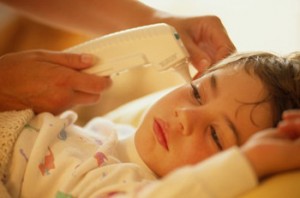Fever is an indication that the body is fighting an infection or illness. In most cases, it is generally harmless. Essentially, it is considered as a good sign that the immune system of the child is working and the body is attempting to heal itself. Even though it is vital to determine the cause, the objective of treatment is to help the child feel better if uncomfortable or in pain.
The normal body temperature tends to vary with age, activity level, general health and time of the day. Among infants, they have higher temperatures than older children. The temperature is usually high between late afternoon and early evening and drops between midnight and early morning. In addition, clothing can affect the body temperature.
The average normal body temperature is 98.6 degrees F. It is important to note that the normal range is 97.5-99.5 degrees F.
What are the indications of fever?

If a child has a fever, he/she might feel warm, sweat more than usual and appear flushed. In addition, the child might be more thirsty than usual.
Some children feel fine even if they have a fever. Nevertheless, most experience symptoms of the condition responsible for the fever. The child might have an earache, rash, sore throat or stomach ache. These indications can provide vital clues as to the cause of the fever.
When to consult a doctor
When caring for a child with fever, it is vital to improve the child’s comfort by ensuring that he/she is given enough fluids to keep the body hydrated and monitor for indications of a serious ailment. It is a good sign if the child normally plays and interacts with you after giving medications for discomfort.
A doctor should be consulted if a child has fever with the following:
- Child appears sick, unusually drowsy or fussy
- Has been to an extremely warm place such as an overheated vehicle
- Has a seizure
- Other symptoms are present such as a stiff neck, severe sore throat, headache, ear pain, unexplained rash or repeated episodes of vomiting or diarrhea
- Has immune system issues such as cancer or sickle cell disease or using steroids
- Child is younger than 3 months with temperature of 100.4 degrees F or higher
- Fever increases above 104 degrees F repeatedly
